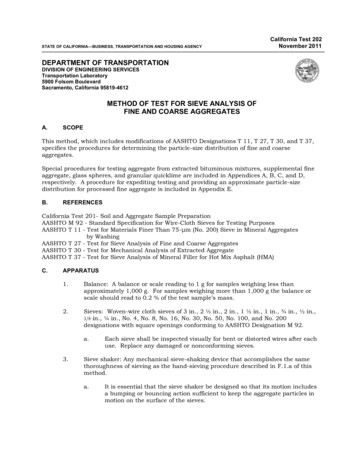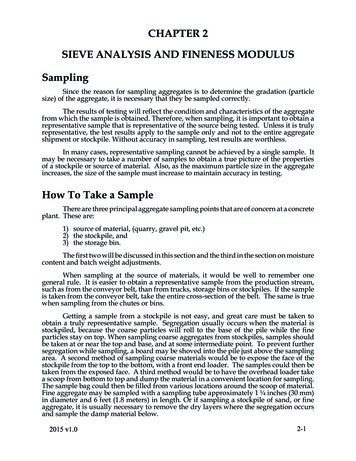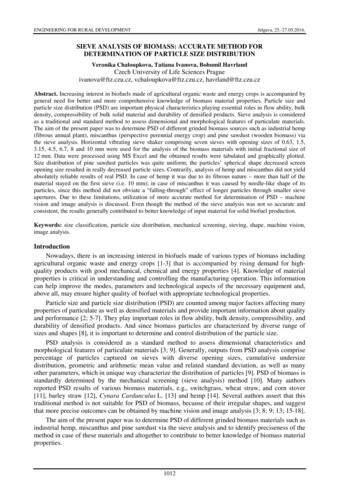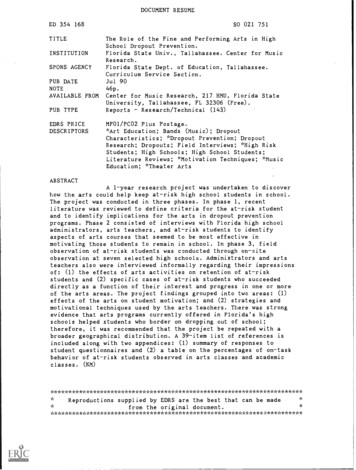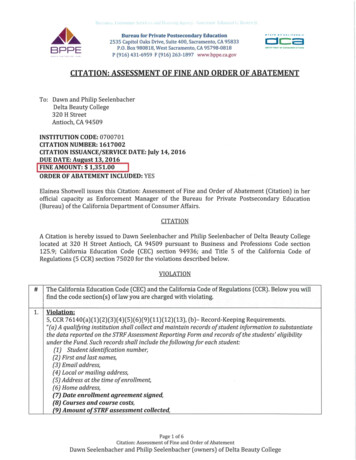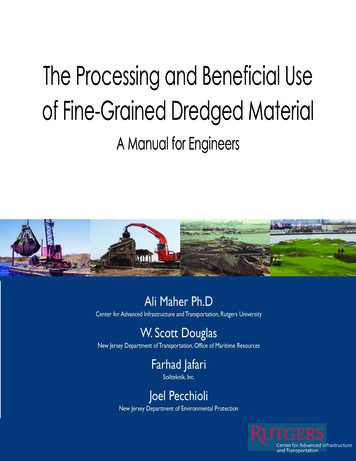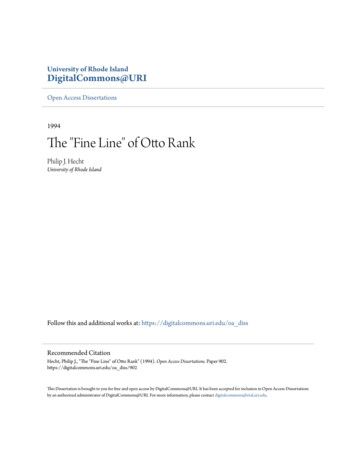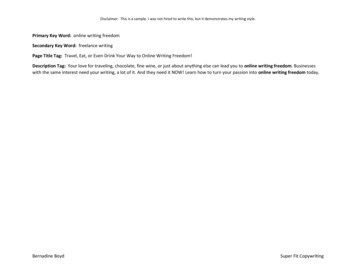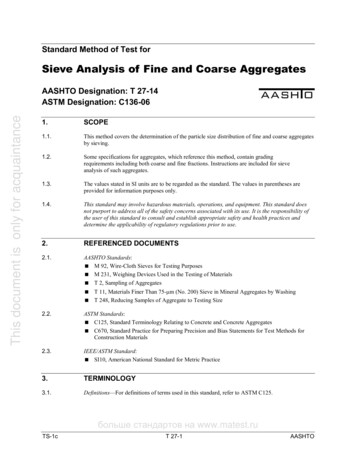
Transcription
Standard Method of Test forSieve Analysis of Fine and Coarse AggregatesThis document is only for acquaintanceAASHTO Designation: T 27-14ASTM Designation: C136-061.SCOPE1.1.This method covers the determination of the particle size distribution of fine and coarse aggregatesby sieving.1.2.Some specifications for aggregates, which reference this method, contain gradingrequirements including both coarse and fine fractions. Instructions are included for sieveanalysis of such aggregates.1.3.The values stated in SI units are to be regarded as the standard. The values in parentheses areprovided for information purposes only.1.4.This standard may involve hazardous materials, operations, and equipment. This standard doesnot purport to address all of the safety concerns associated with its use. It is the responsibility ofthe user of this standard to consult and establish appropriate safety and health practices anddetermine the applicability of regulatory regulations prior to use.2.REFERENCED DOCUMENTS2.1.AASHTO Standards: M 92, Wire-Cloth Sieves for Testing Purposes M 231, Weighing Devices Used in the Testing of Materials T 2, Sampling of Aggregates T 11, Materials Finer Than 75-µm (No. 200) Sieve in Mineral Aggregates by Washing T 248, Reducing Samples of Aggregate to Testing Size2.2.ASTM Standards: C125, Standard Terminology Relating to Concrete and Concrete Aggregates C670, Standard Practice for Preparing Precision and Bias Statements for Test Methods forConstruction Materials2.3.IEEE/ASTM Standard: SI10, American National Standard for Metric Practice3.TERMINOLOGY3.1.Definitions—For definitions of terms used in this standard, refer to ASTM C125.больше стандартов на www.matest.ruTS-1cT 27-1AASHTO
This document is only for acquaintance4.SUMMARY OF METHOD4.1.A sample of dry aggregate of known mass is separated through a series of sieves of progressivelysmaller openings for determination of particle size distribution.5.SIGNIFICANCE AND USE5.1.This method is used primarily to determine the grading of materials proposed for use as aggregatesor being used as aggregates. The results are used to determine compliance of the particle sizedistribution with applicable specification requirements and to provide necessary data for control ofthe production of various aggregate products and mixtures containing aggregates. The data mayalso be useful in developing relationships concerning porosity and packing.5.2.Accurate determination of material finer than the 75-µm (No. 200) sieve cannot be achieved byuse of this method alone. Test Method T 11 for material finer than the 75-µm (No. 200) sieve bywashing should be employed.6.APPARATUS6.1.Balance—The balance shall have sufficient capacity, be readable to 0.1 percent of the samplemass, or better, and conform to the requirements of M 231.6.2.Sieves—The sieve cloth shall be mounted on substantial frames constructed in a manner that willprevent loss of material during sieving. The sieve cloth and standard sieve frames shall conform tothe requirements of M 92. Nonstandard sieve frames shall conform to the requirements of M 92as applicable.Note 1—It is recommended that sieves mounted in frames larger than standard 203.2 mm (8 in.)diameter be used for testing coarse aggregate to reduce the possibility of overloading the sieves.See Section 8.3.6.3.Mechanical Sieve Shaker—A mechanical sieving device, if used, shall create motion of the sievesto cause the particles to bounce, tumble, or otherwise turn so as to present different orientations tothe sieving surface. The sieving action shall be such that the criterion for adequacy of sievingdescribed in Section 8.4 is met in a reasonable time period.Note 2—Use of a mechanical sieve shaker is recommended when the size of the sample is 20 kg(44 lb) or greater, and may be used for smaller samples, including fine aggregate. Excessive time(more than approximately 10 min) to achieve adequate sieving may result in degradation of thesample. The same mechanical sieve shaker may not be practical for all sizes of samples becausethe large sieving area needed for practical sieving of a large nominal size coarse aggregate verylikely could result in loss of a portion of the sample if used for a smaller sample of coarseaggregate or fine aggregate.6.4.Oven—An oven of appropriate size capable of maintaining a uniform temperature of 110 5 C(230 9 F).7.SAMPLING7.1.Sample the aggregate in accordance with T 2. The mass of the field sample shall be the massshown in T 2 or four times the mass required in Sections 7.4 and 7.5 (except as modified inSection 7.6), whichever is greater.больше стандартов на www.matest.ruTS-1cT 27-2AASHTO
Thoroughly mix the sample and reduce it to an amount suitable for testing using the applicableprocedures described in T 248. The sample for test shall be the approximate mass desired whendry and shall be the end result of the reduction. Reduction to an exact predetermined mass shallnot be permitted.7.2.This document is only for acquaintanceNote 3—Where sieve analysis, including determination of material finer than the 75-µm(No. 200) sieve, is the only testing proposed, the size of the sample may be reduced in the fieldto avoid shipping excessive quantities of extra material to the laboratory.7.3.Fine Aggregate—The size of the test sample of aggregate, after drying, shall be 300 g minimum.7.4.Coarse Aggregate—The mass of the test sample of coarse aggregate shall conform withthe following:Nominal MaximumSize SquareOpenings,mm (in.)Minimum Massof Test Sample,kg (lb)9.5 (3/8)12.5 (1/2)19.0 (3/4)25.0 (1)37.5 (11/2)50 (2)63 (21/2)75 (3)90 (31/2)100 (4)125 (5)1 (2)2 (4)5 (11)10 (22)15 (33)20 (44)35 (77)60 (130)100 (220)150 (330)300 (660)7.5.Coarse and Fine Aggregates Mixtures—The mass of the test sample of coarse and fine aggregatemixtures shall be the same as for coarse aggregate in Section 7.4.7.6.Samples of Large-Size Coarse Aggregate—The size of sample required for aggregate with 50-mm(2-in.) nominal maximum size or larger is such as to preclude convenient sample reduction andtesting as a unit except with large mechanical splitters and sieve shakers. As an option when suchequipment is not available, instead of combining and mixing sample increments and then reducingthe field sample to testing size, conduct the sieve analysis on a number of approximately equalsample increments such that the total mass tested conforms to the requirements of Section 7.4.7.7.In the event that the amount of material finer than the 75-µm (No. 200) sieve is to be determinedby T 11, use the procedure described in Section 7.7.1 or 7.7.2, whichever is applicable.7.7.1.For aggregates with a nominal maximum size of 12.5 mm (1/2 in.) or less, use the same testsample for testing by T 11 and this method. First test the sample in accordance with T 11 throughthe final drying operation, then dry sieve the sample as stipulated in Sections 8.2 through 8.6 ofthis method.7.7.2.For aggregates with a nominal maximum size greater than 12.5 mm (1/2 in.), a single testsample may be used as described in Section 7.7.1 or separate test samples may be used for T 11and this method.7.7.3.Where the specification requires determination of the total amount of material finer than the75-µm (No. 200) sieve by washing and dry sieving, use the procedure described in Section 7.7.1.больше стандартов на www.matest.ruTS-1cT 27-3AASHTO
This document is only for acquaintance8.PROCEDURE8.1.If the test sample has not been subjected to testing by T 11, dry it to constant mass at atemperature of 110 5 C (230 9 F). Determine and record the mass of material that will beplaced on the sieves to the accuracy of the balance as defined in Section 6.1.Note 4—For control purposes, particularly where rapid results are desired, it is generally notnecessary to dry coarse aggregate for the sieve analysis test. The results are little affected by themoisture content unless (1) the nominal maximum size is smaller than about 12.5 mm (1/2 in.),(2) the coarse aggregate contains appreciable material finer than 4.75 mm (No. 4), or (3) thecoarse aggregate is highly absorptive (a lightweight aggregate, for example). Also, samples maybe dried at the higher temperature associated with the use of hot plates without affecting results,provided steam escapes without generating pressures sufficient to fracture the particles, andtemperatures are not so great as to cause chemical breakdown of the aggregate.8.2.Select sieves with suitable openings to furnish the information required by the specificationscovering the material to be tested. Use additional sieves as desired or necessary to provide otherinformation, such as fineness modulus, or to regulate the amount of material on a sieve. Nest thesieves in order of decreasing size of opening from top to bottom and place the sample, or portionof the sample if it is to be sieved in more than one increment, on the top sieve. Agitate the sievesby hand or by mechanical apparatus for a sufficient period, established by trial or checked bymeasurement on the actual test sample, to meet the criterion for adequacy of sieving described inSection 8.4.8.3.Limit the quantity of material on a given sieve so that all particles have opportunity to reach sieveopenings a number of times during the sieving operation. For sieves with openings smaller than4.75-mm (No. 4), the quantity retained on any sieve at the completion of the sieving operationshall not exceed 7 kg/m2 (4 g/in.2) of sieving surface area (Note 5). For sieves with openings4.75 mm (No. 4) and larger, the quantity retained in kg shall not exceed the product of 2.5 (sieveopening, mm (effective sieving area, m2)). This quantity is shown in Table 1 for five sieve-framedimensions in common use. In no case shall the quantity retained be so great as to causepermanent deformation of the sieve cloth.8.3.1.Prevent an overload of material on an individual sieve by one or a combination of the followingmethods:8.3.1.1.Insert an additional sieve with opening size intermediate between the sieve that may be overloadedand the sieve immediately above that sieve in the original set of sieves.8.3.1.2.Split the sample into two or more portions, sieving each portion individually. Combine the massesof the several portions retained on a specific sieve before calculating the percentage of the sampleon the sieve.8.3.1.3.Use sieves having a larger frame size and providing greater sieving area.Note 5—The 7 kg/m2 amounts to 200 g for the usual 203.2-mm (8-in.) diameter sieve (witheffective sieving surface diameter of 190.5 mm (7.5 in.)).8.3.1.4.In the case of coarse and fine aggregate mixtures, the portion of the sample finer than the 4.75-mm(No. 4) sieve may be distributed among two or more sets of sieves to prevent overloading ofindividual sieves.8.3.1.5.Alternatively, the portion finer than the 4.75-mm (No. 4) sieve may be reduced in size using amechanical splitter according to T 248. If this procedure is followed, compute the mass of eachsize increment of the original sample as follows:больше стандартов на www.matest.ruTS-1cT 27-4AASHTO
AW1 BW2This document is only for acquaintancewhere:A W1 W2 B (1)mass of size increment on total sample basis,mass of fraction finer than 4.75-mm (No. 4) sieve in total sample,mass of reduced portion of material finer than 4.75-mm (No. 4) sieve actually sieved, andmass of size increment in reduced portion sieved.Table 1—Maximum Allowable Quantity of Material Retained on a Sieve, kgSieveOpening Size203.2-mm,diab0.0285125 mm (5 in.)100 mm (4 in.)90 mm (3 1/2 in.)75 mm (3 in.)63 mm (2 1/2 in.)50 mm (2 in.)37.5 mm (1 1/2 in.)25.0 mm (1 in.)19.0 mm (3/4 in.)12.5 mm (1/2 in.)9.5 mm (3/8 in.)4.75 mm (No. 4)abcNominal Dimensions of Sievea254-mm,304.8-mm,350 by 350,diabdiabmmSieving Area, .10.54372 by 75.12.6Sieve frame dimensions in inch units: 8.0-in. diameter; 10.0-in. diameter; 12.0-in. diameter; 13.8 by 13.8 in. (14 by 14 in. nominal); 14.6 by22.8 in. (16 by 24 in. nominal).The sieve area for round sieves is based on an effective diameter 12.7 mm (1/2 in.) less than the nominal frame diameter, because M 92permits the sealer between the sieve cloth and the frame to extend 6.35 mm (1/4 in.) over the sieve cloth. Thus the effective sieving diameterfor a 203.2-mm (8.0-in.) diameter sieve frame is 190.5 mm (7.5 in.). Sieves produced by some manufacturers do not infringe on the sievecloth by the full 6.35 mm (1/4 in.).Sieves indicated have less than five full openings and should not be used for sieve testing.8.4.Continue sieving for a sufficient period and in such manner that, after completion, not morethan 0.5 percent by mass of the total sample passes any sieve during 1 min of continuoushand sieving performed as follows: Hold the individual sieve, provided with a snug-fitting panand cover, in a slightly inclined position in one hand. Strike the side of the sieve sharply andwith an upward motion against the heel of the other hand at the rate of about 150 times per minute,turn the sieve about one sixth of a revolution at intervals of about 25 strokes. In determiningsufficiency of sieving for sizes larger than the 4.75-mm (No. 4) sieve, limit the material onthe sieve to a single layer of particles. If the size of the mounted testing sieves makes thedescribed sieving motion impractical, use 203.2-mm (8-in.) diameter sieves to verify thesufficiency of sieving.8.5.Unless a mechanical sieve shaker is used, hand sieve particles obtained on the 75 mm (3 in.) bydetermining the smallest sieve opening through which each particle will pass by rotating theparticles, if necessary, in order to determine whether they will pass through a particular opening;however, do not force particles to pass through an opening.больше стандартов на www.matest.ruTS-1cT 27
TS-1c T 27-3 AASHTO 7.2. Thoroughly mix the sample and reduce it to an amount suitable for testing using the applicable procedures described in T 248. The sample for test shall be the approximate mass desired when dry and shall be the end result of the reduction. Reduction to an exact predetermined mass shall not be permitted. Note 3—Where sieve analysis, including determination of material .
